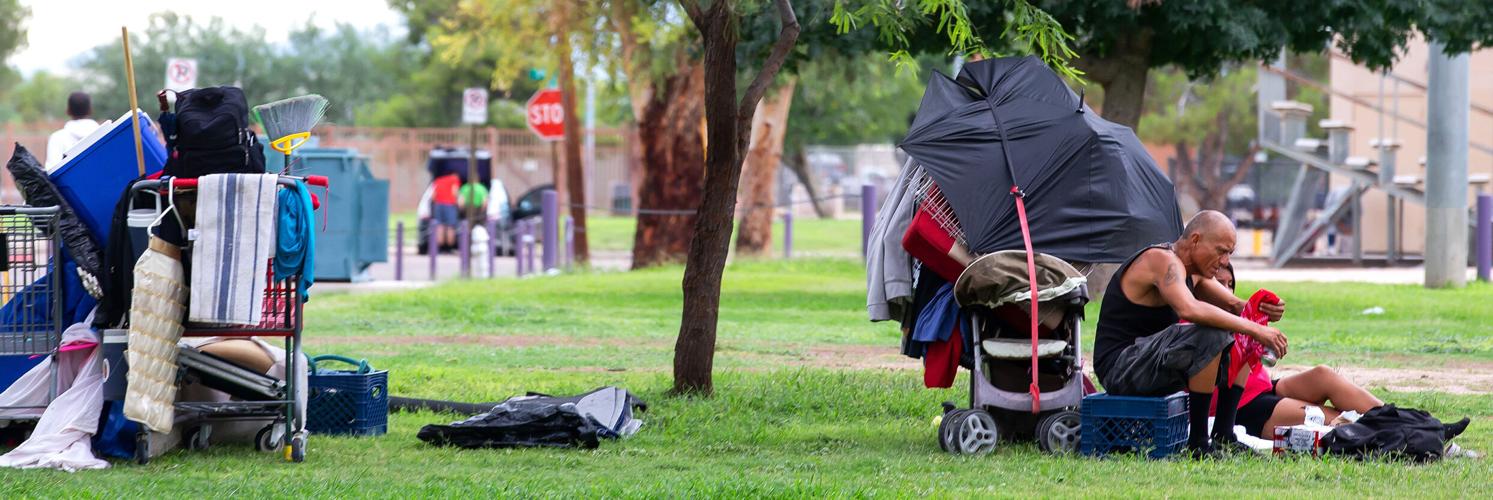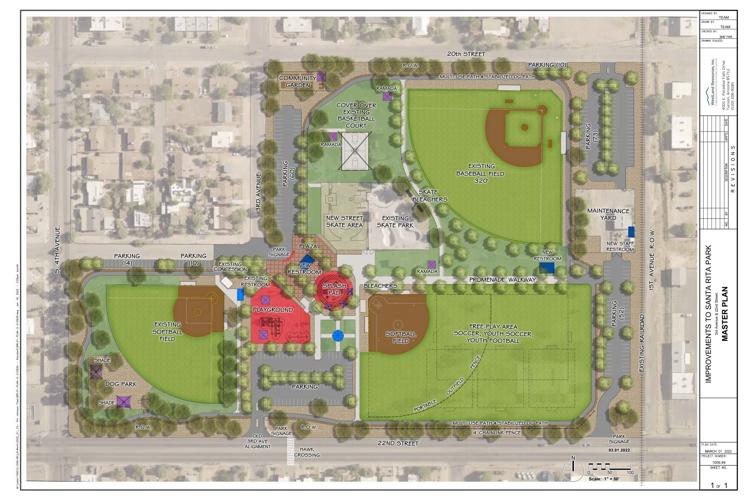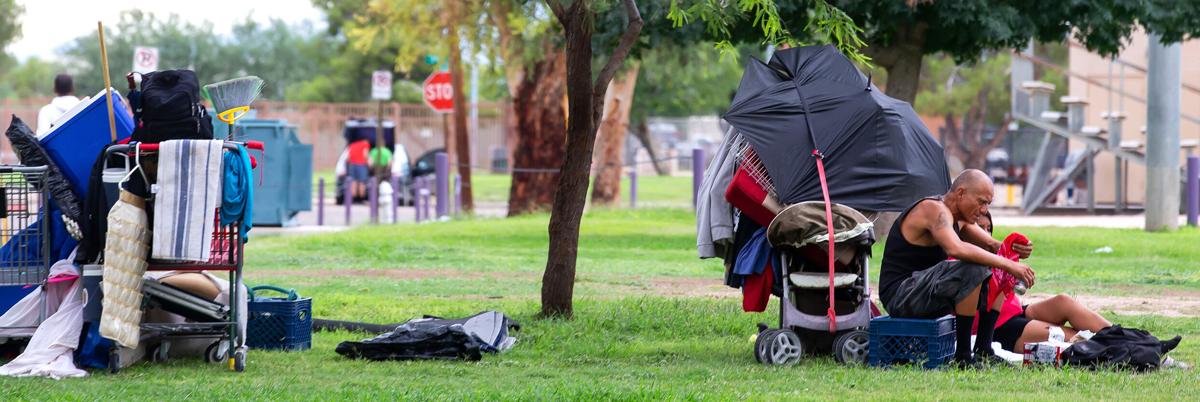Among the dozens of homeless individuals congregating under the temporary relief of shade the trees scattered throughout Santa Rita Park provide, 62-year-old Lydia Soto sits on a knitted blanket and sips from a plastic water bottle.
She rests at the park between stays at shelters, a temporary home base until Soto can get back on a shelter’s waiting list for entry. Santa Rita Park is the closest midpoint in between her stays at local shelters, she says.
“I was born and raised here all my life and got stuck, you know, renting apartments that were not being fixed or not being utilized the right way … the system is slow right now,” she said. “It’s been a year, like this repetitious kind of thing. So I’m getting lined up with housing the best I can.”
Santa Rita Park has long been a gathering place for houseless people, and now, it’s set to get nearly $3 million worth of improvements that Tucson City Council approved Tuesday. The park’s renovation, however, has faced pushback over what construction will mean for the large community of homeless individuals residing there.
Soto says she’ll find another in-between shelter if the park’s construction displaces her, but she worries for others she spends the days with at the park.
“I don’t know what they would do,” she said. “But it’s really sad to see them suffer.”
Since January 2021, the city’s engaged with community members through virtual and in-person meetings and surveys assessing what they want to see at the park. Phase one of the master plan for Santa Rita Park includes a new dog park, playground and a walking path.
Throughout the city’s community engagement meetings, many neighbors have complained they don’t feel safe at the park due to drug use and unsanitary conditions, and that excess litter and makeshift shelters are an eyesore.
But another group has continually advocated for the homeless people at the park, arguing the new construction will drive out the unsheltered who have no other place to go. That message resounded at Tuesday’s council meeting, where those opposed to the master plan filled nearly every seat and speaking slot during the call to the audience, donning signs that read “stop the sweep” and “homelessness is not a crime.”
“They claim that they are reviving the park, but in reality, they are further displacing, harming, arresting and killing people by doing this,” said Victoria DeVasto, who is part of the outreach organization Community on Wheels, which supplies basic necessities to homeless people at the park. “They have no place to go. The shelters are full, they’re predominantly full, or there is very little space. And the restrictions and eligibility requirements to get into those shelters are insane.”
But the city says the master plan is part of an overarching strategy to improve Tucson’s parks — not a scheme to push out homeless individuals. Brandi Champion, the city’s housing first director, said her department hopes to offer shelter to those at Santa Rita Park before construction displaces them.
“As with everyone unsheltered on the street, we’re hopeful that we can get them all in a shelter situation that they’ll be willing to accept,” she said.

The city of Tucson plans to spend $3 million on the first phase of renovations to Santa Rita Park. Upgrades include a new splash pad, dog park and playground, but many are concerned about the construction’s impact on the homeless community residing at the park.
Santa Rita’s master plan
The overhaul of Santa Rita Park is part of the $225 million Proposition 407 bond package voters approved in 2018 to improve city park amenities. Phase one of the park’s upgrades has an estimated price of $2.9 million, but the entire master plan is estimated to cost over $10 million.
But according to Tucson Parks and Recreation Director Lara Hamwey, Proposition 407 funds won’t cover the entire cost of Santa Rita Park’s master plan, so the city plans on “aggressively seeking additional funding” from grants, development impact fees and American Rescue Plan Act funds.
“We made a commitment to the public when they voted to pass (Proposition 407). So we are committed to delivering through with those, whether it’s deferred maintenance replacements or new features in the park because that’s what they voted and asked for. So that’s really what we’re doing right now,” Hamwey said.
It will likely be at least a year before the city breaks ground on the Santa Rita improvements, according to Hamwey, after the design and permitting processes are finished.
But while the initial schematics of the project have earned city council approval, the city has yet to establish a set plan for the homeless individuals who depend on the park for shelter.
Hamwey said the parks and recreation department will work closely with Tucson police, the city’s housing first department and the Community Safety, Health and Wellness Program, a new initiative the city hired a director to lead in January.
“What I forecast is working in very close partnership with them when we start getting into a permitting window to say, what are we going to do? How are we going to accommodate?” Hamwey said. “I certainly can’t tell you what a solution is going to be. It’s going to be what we do now, which is we meet whenever we have something that we need to triage together and figure out what makes the most sense.”

Glenda Avalos, left, supporter of unhoused individuals, speaks during the call to the audience at a Tucson City Council meeting on Aug. 9. Advocates who packed the meeting say the city needs a defined plan for the people residing in Santa Rita Park in addition to a master plan for the park’s amenities.
Housing first
Santa Rita Park’s proximity to social service organizations and the frequent visits it receives from local aid groups has helped the unsheltered population survive, but has also abetted the park’s reputation for gatherings of homeless people.
The dichotomy has created a difficult situation for city officials who collaborate with nonprofits on homeless outreach programs but also receive complaints from local neighborhoods about conditions at the park.
“We realize that sometimes our service system can contribute to the community challenge, and while it’s very much intended to create a solution, it can be a painful solution for folks who live in those neighborhoods and around,” Jason Thorpe, a community services administrator for Tucson’s Planning and Community Development Division said during the first virtual town hall on the Santa Rita master plan in January 2021.
Thorpe said the city is trying to coordinate services that link homeless people to long-term housing, as the shelters surrounding Santa Rita Park “are a place to sleep at night, but not a place to be during the day.”
The city’s strategy for addressing homelessness is to prioritize getting people into independent housing without barriers to entry while providing wraparound support services like independent living programs and behavioral health services.
The housing first approach is being utilized at the city-run shelter at the Wildcat Inn and at Desert Cove Country Club that Tucson bought with $1.2 million with federal pandemic relief funds.
Champion from the city’s housing first department says she hopes the expansion of low-barrier shelters will help the unsheltered at Santa Rita Park.
“With these low-barrier shelters that we’re starting to pilot in the community, we noticed that we get a bigger buy-in on that, and I’m hoping that we can get people once that construction starts,” she said. “I’m sure that our team will be called out to do intensive outreach on that area well before that and leading up to that.”
While many advocates for the rights of the homeless people at Santa Rita Park have protested against any potential “sweep” of the area, the Tucson Police Department says it won’t move the unsheltered out of the park.
“The concept of sweeps is not an accurate description in regards to the police department’s involvement and what’s going on in the parks,” said Lt. James Brady, the community outreach and resource engagement commander for TPD. “We don’t sweep parks, we don’t sweep homeless encampments. Really, our posture is much more around the idea of outreach, trying to engage them with community partners through our city’s housing first program.”
But the advocates who packed Tuesday’s council meeting say the city needs a defined plan for the people residing in Santa Rita Park in addition to a master plan for the park’s amenities.
“It’s just really strange that there is this whole master plan with Santa Rita, but there’s no pre-plan to figure out how do we properly ethically work with the unhoused?” said Xavier Martinez, who works with DeVasto in the Community on Wheels program and spoke to the council at Tuesday’s meeting. “How do we work with the members of the city of Tucson who have the ability to build that trust with those folks to ensure that they find a safe place to live?”
Laura Conover announced she will not remove the conviction of Louis Taylor, who served 42 years in prison after being convicted of starting the fire that killed 29 people in 1970.
The Pima County Board of Supervisors passed a resolution Tuesday to assess its options in challenging a state statute that preempts local gun control laws.
For Star subscribers: Only 25% of 911 calls are emergency calls, says Tucson Mayor Regina Romero. A new 311 system will reroute calls that seek non-emergency services involving such issues as mental health and substance use.










